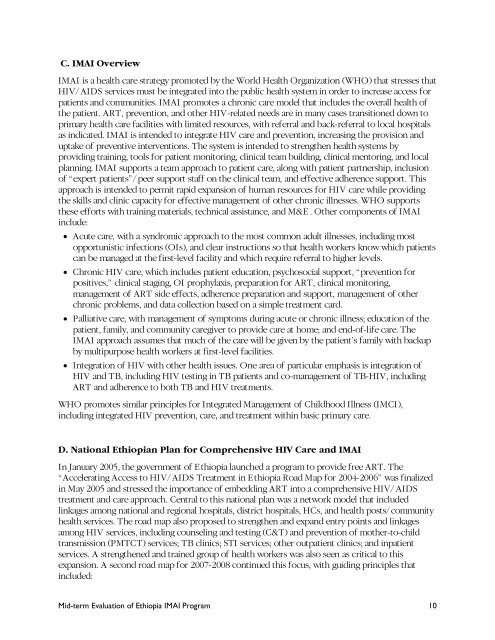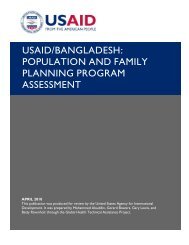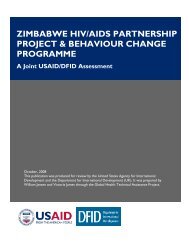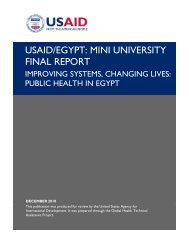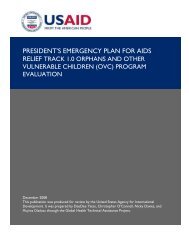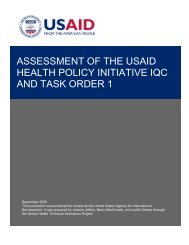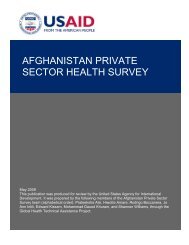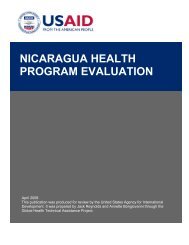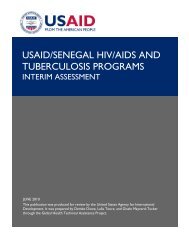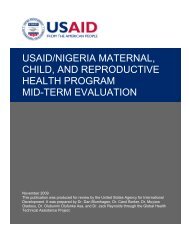usaid/ethiopia pepfar mid-term evaluation of the ... - GH Tech
usaid/ethiopia pepfar mid-term evaluation of the ... - GH Tech
usaid/ethiopia pepfar mid-term evaluation of the ... - GH Tech
- No tags were found...
Create successful ePaper yourself
Turn your PDF publications into a flip-book with our unique Google optimized e-Paper software.
C. IMAI OverviewIMAI is a health care strategy promoted by <strong>the</strong> World Health Organization (WHO) that stresses thatHIV/ AIDS services must be integrated into <strong>the</strong> public health system in order to increase access forpatients and communities. IMAI promotes a chronic care model that includes <strong>the</strong> overall health <strong>of</strong><strong>the</strong> patient. ART, prevention, and o<strong>the</strong>r HIV-related needs are in many cases transitioned down toprimary health care facilities with limited resources, with referral and back-referral to local hospitalsas indicated. IMAI is intended to integrate HIV care and prevention, increasing <strong>the</strong> provision anduptake <strong>of</strong> preventive interventions. The system is intended to streng<strong>the</strong>n health systems byproviding training, tools for patient monitoring, clinical team building, clinical mentoring, and localplanning. IMAI supports a team approach to patient care, along with patient partnership, inclusion<strong>of</strong> “expert patients”/peer support staff on <strong>the</strong> clinical team, and effective adherence support. Thisapproach is intended to permit rapid expansion <strong>of</strong> human resources for HIV care while providing<strong>the</strong> skills and clinic capacity for effective management <strong>of</strong> o<strong>the</strong>r chronic illnesses. WHO supports<strong>the</strong>se efforts with training materials, technical assistance, and M&E . O<strong>the</strong>r components <strong>of</strong> IMAIinclude:• Acute care, with a syndromic approach to <strong>the</strong> most common adult illnesses, including mostopportunistic infections (OIs), and clear instructions so that health workers know which patientscan be managed at <strong>the</strong> first-level facility and which require referral to higher levels.• Chronic HIV care, which includes patient education, psychosocial support, “prevention forpositives,” clinical staging, OI prophylaxis, preparation for ART, clinical monitoring,management <strong>of</strong> ART side effects, adherence preparation and support, management <strong>of</strong> o<strong>the</strong>rchronic problems, and data collection based on a simple treatment card.• Palliative care, with management <strong>of</strong> symptoms during acute or chronic illness; education <strong>of</strong> <strong>the</strong>patient, family, and community caregiver to provide care at home; and end-<strong>of</strong>-life care. TheIMAI approach assumes that much <strong>of</strong> <strong>the</strong> care will be given by <strong>the</strong> patient’s family with backupby multipurpose health workers at first-level facilities.• Integration <strong>of</strong> HIV with o<strong>the</strong>r health issues. One area <strong>of</strong> particular emphasis is integration <strong>of</strong>HIV and TB, including HIV testing in TB patients and co-management <strong>of</strong> TB-HIV, includingART and adherence to both TB and HIV treatments.WHO promotes similar principles for Integrated Management <strong>of</strong> Childhood Illness (IMCI),including integrated HIV prevention, care, and treatment within basic primary care.D. National Ethiopian Plan for Comprehensive HIV Care and IMAIIn January 2005, <strong>the</strong> government <strong>of</strong> E thiopia launched a program to provide free ART. The“Accelerating Access to HIV/ AIDS Treatment in E thiopia Road Map for 2004-2006” was finalizedin May 2005 and stressed <strong>the</strong> importance <strong>of</strong> embedding ART into a comprehensive HIV/ AIDStreatment and care approach. Central to this national plan was a network model that includedlinkages among national and regional hospitals, district hospitals, HCs, and health posts/ communityhealth services. The road map also proposed to streng<strong>the</strong>n and expand entry points and linkagesamong HIV services, including counseling and testing (C&T) and prevention <strong>of</strong> mo<strong>the</strong>r-to-childtransmission (PMTCT) services; TB clinics; STI services; o<strong>the</strong>r outpatient clinics; and inpatientservices. A streng<strong>the</strong>ned and trained group <strong>of</strong> health workers was also seen as critical to thisexpansion. A second road map for 2007-2008 continued this focus, with guiding principles thatincluded:Mid-<strong>term</strong> Evaluation <strong>of</strong> Ethiopia IMAI Program 10


